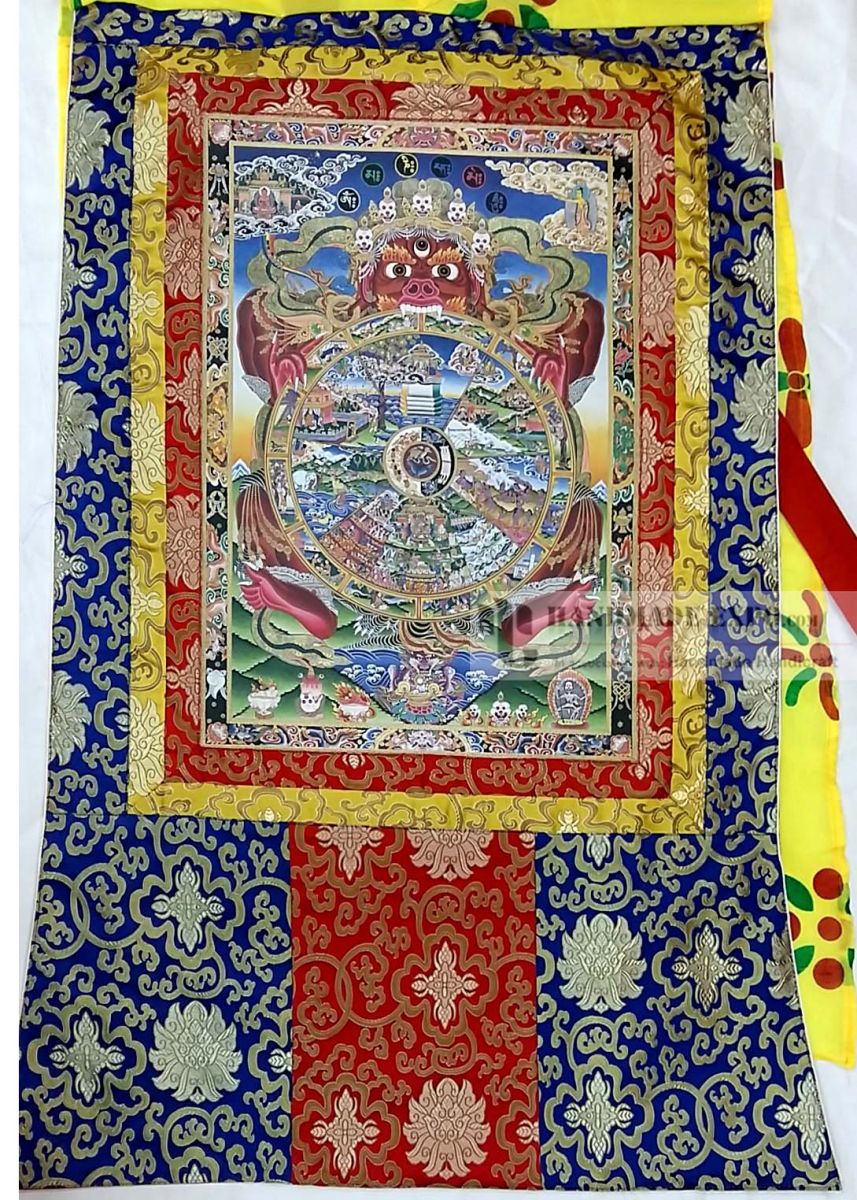
It is possible that we still have it with our suppliers but the price could be different from before.
Feel free to order. We will verify availability and inform you promptly.

Safe Payment
We accept Paypal, Money Transfer, Bank Transfer
Confidence
Protection covers your purchase and personal data.
Worldwide Delivery
We ship Worldwide, except Russia.Shipping cost US$25.2 for upto 0.5 kgs

Hotline
Talk to help line for your question on 9841267335Second Layer Karma
The second layer of the wheel shows two-half circles:
One half-circle (usually light) shows contented people moving upwards to higher states, possibly to the higher realms.
The other half-circle (usually dark) shows people in a miserable state being led downwards to lower states, possibly to the lower realms.
These images represent karma, the law of cause and effect. The light half-circle indicates people experiencing the results of positive actions. The dark half-circle indicates people experiencing the results of negative actions.
God realm:the gods lead long and enjoyable lives full of pleasure and abundance, but they spend their lives pursuing meaningless distractions and never think to practice the dharma. When death comes to them, they are completely unprepared; without realizing it, they have completely exhausted their good karma (which was the cause for being reborn in the god realm) and they suffer through being reborn in the lower realms
Demi-god realm:the demi-gods have pleasure and abundance almost as much as the gods, but they spend their time fighting among themselves or making war on the gods. When they make war on the gods, they always lose, since the gods are much more powerful. The demi-gods suffer from constant fighting and jealousy, and from being killed and wounded in their wars with each other and with the gods.
Human realm: humans suffer from hunger, thirst, heat, cold, separation from friends, being attacked by enemies, not getting what they want, and getting what they don't want. They also suffer from the general sufferings of birth, old age, sickness and death. Yet the human realm is considered to be the most suitable realm for practicing the dharma, because humans are not completely distracted by pleasure (like the gods or demi-gods) or by pain and suffering (like the beings in the lower realms).
The three lower realms are:
Animal realm: wild animals suffer from being attacked and eaten by other animals; they generally lead lives of constant fear. Domestic animals suffer from being exploited by humans; for example, they are slaughtered for food, overworked, and so on.
Hungry ghost realm: hungry ghosts suffer from extreme hunger and thirst. They wander constantly in search of food and drink, only to be miserably frustrated any time them come close to actually getting what they want. For example, they see a stream of pure, clear water in the distance, but by the time the get there the stream has dried up. Hungry ghosts have huge bellies and long thin necks. On the rare occasions that they do manage to find something to eat or drink, the food or water burns their neck as it goes down to their belly, causing them intense agony.
Hell realm: hell beings endure unimaginable suffering for eons of time. There are actually eighteen different types of hells, each inflicting a different kind of torment. In the hot hells, beings suffer from unbearable heat and continual torments of various kinds. In the cold hells, beings suffer from unbearable cold and other torments.
Generally speaking, each realm is said to be the result of one of the six main negative emotions: pride, jealousy, desire, ignorance, greed, and anger. Dzongsar Khyentse states:
So we have six realms. Loosely, you can say when the perception comes more from aggression, you experience things in a hellish way. When your perception is filtered through attachment, grasping or miserliness, you experience the hungry ghost realm. When your perception is filtered through ignorance, then you experience the animal realm. When you have a lot of pride, you are reborn in the god realm. When you have jealousy, you are reborn in the asura (demi-god) realm. When you have a lot of passion, you are reborn in the human realm. Among the six realms, the human realm is considered to offer the best opportunity to practice the dharma. Dzongsar Khyentse states:
If we need to judge the value of these six realms, the Buddhists would say the best realm is the human realm. Why is this the best realm? Because you have a choice... The gods don't have a choice. Why? They're too happy. When you are too happy you have no choice. You become arrogant. The hell realm: no choice, too painful. The human realm: not too happy and also not too painful. When you are not so happy and not in so much pain, what does that mean? A step closer to the normality of mind, remember? When you are really, really excited and in ecstasy, there is no normality of mind. And when you are totally in pain, you don't experience normality of mind either. So someone in the human realm has the best chance of acquiring that normality of mind. And this is why in Buddhist prayers you will always read: ideally may we get out of this place, but if we can't do it within this life, may we be reborn in the human realm, not the others.
Sometimes, the wheel is represented as only having five realms because the God realm and the Demi-god realm are combined into a single realm.
In some representations of the wheel, there is a buddha or bodhisattva depicted within each realm, trying to help sentient beings find their way to nirvana.
Ignorance is the first of the 12 causes and conditions, both of our rebirth and of maturing any karma within our dependent existence. Different causes can overlap in different stages and even mature in next existences - lives. Yet the turning of the wheel goes onward.
The twelve causal links, paired with their common visual representations, are:
Avidyā lack of knowledge - a blind person, often walking, or a person peering out.
Saṃskāra constructive volitional activity - a potter shaping a vessel or vessels.
Vijnāna consciousness - a man or a monkey grasping a fruit.
Nāmarūpa name and form (constituent elements of mental and physical existence) - two men afloat in a boat.
Ṣaḍāyatana six senses (eye, ear, nose, tongue, body, and mind) - a dwelling with six windows.
Sparśa contact - lovers consorting, kissing, or entwined.
Vedanā pain - an arrow to the eye.
Tṛṣṇa thirst - a drinker receiving drink.
Upādāna grasping - a man or a monkey picking fruit.
Bhava coming to be - a couple engaged in intercourse, a standing, leaping, or reflective person.
Jāti being born - woman giving birth.
arāmaraṇa old age and death - corpse being carried
The wheel is being held by a fearsome figure who represents impermanence. The Dalai Lama states:
The fierce being holding the wheel symbolizes impermanence, which is why the being is a wrathful monster, though there is no need for it to be drawn with ornaments and so forth... Once I had such a painting drawn with a skeleton rather than a monster, in order to symbolize impermanence more clearly.
This figure is most commonly depicted as Yama, the lord of death. Regardless of the figure depicted, the inner meaning remains the same-that the entire process of cyclic existence (samsara) is transient; everything within this wheel is constantly changing.
Yama has the following attributes:
He wears of crown of five skulls that symbolize the impermanence of the five aggregates. (The skulls are also said to symbolize the five poisons.)
He has a third eye that symbolizes the wisdom of understanding impermanence
He is sometimes shown adorned with a tiger skin, which symbolizes fearfulness.(The tiger skin is typically seen hanging beneath the wheel.)
His four limbs (that are clutching the wheel) symbolize the sufferings of birth, old age, sickness, and death.
The Buddha and the moon: liberation Drawings of the bhavacakra include symbols outside of the wheel that represent the possibility of liberation from six realms. In most drawings, this is represented by the buddha pointing toward the moon (as shown in painting from Thikse monastery, at right); in this case:
The Buddha pointing toward the moon represents the Buddha's teachings or the path to liberation. And the moon represents liberation itself.





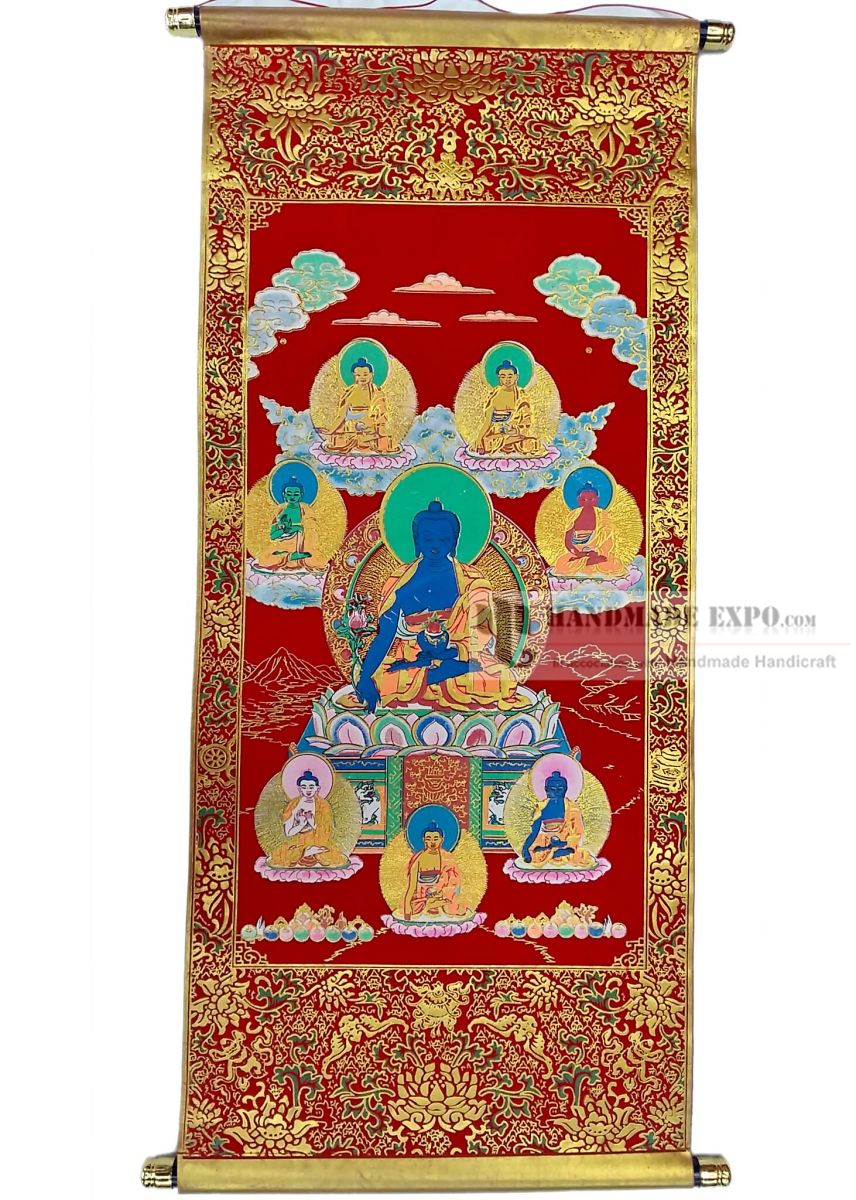
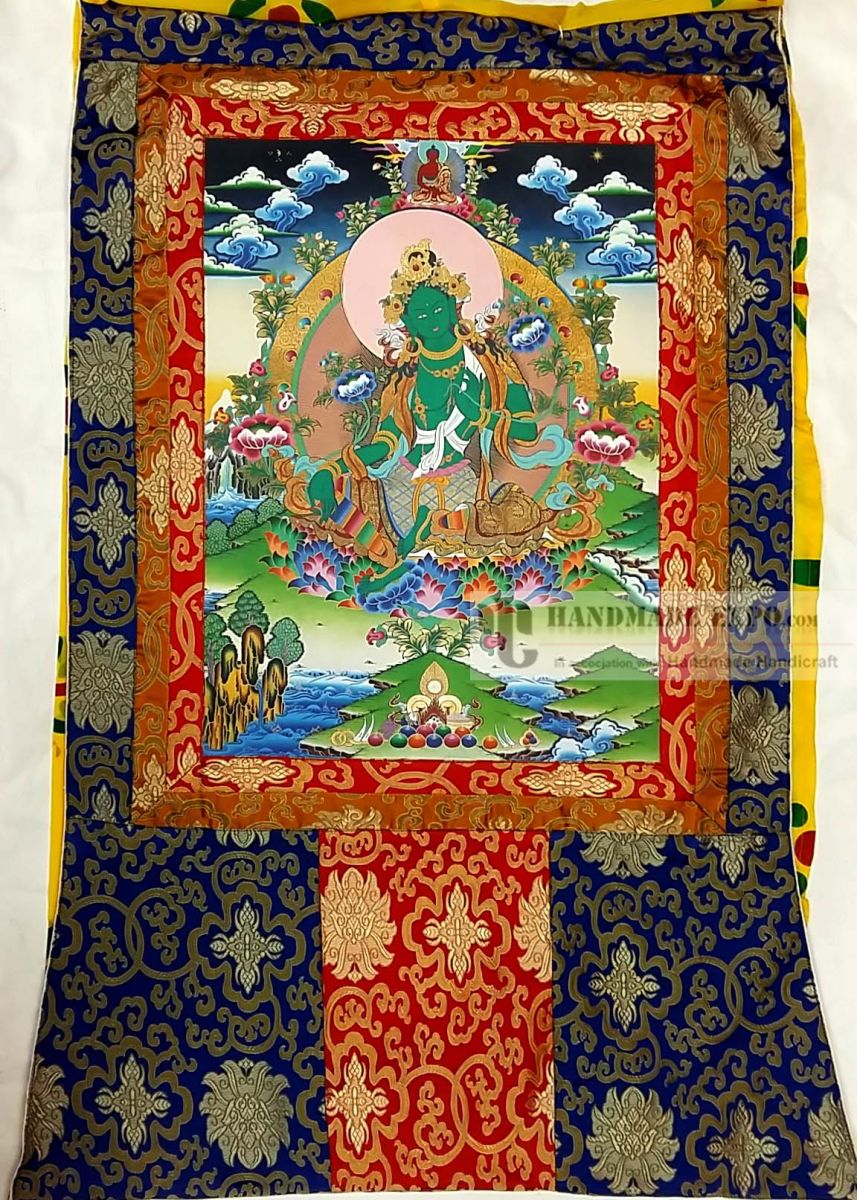 with Brocade" title="Green Tara Printed Thangka
with Brocade" title="Green Tara Printed Thangka  Screen Printed,
Screen Printed,  Screen Printed,
Screen Printed, 

 of Padmasambhava Embossed Screen Print" title="8 Forms
of Padmasambhava Embossed Screen Print" title="8 Forms  Screen Printed,
Screen Printed, 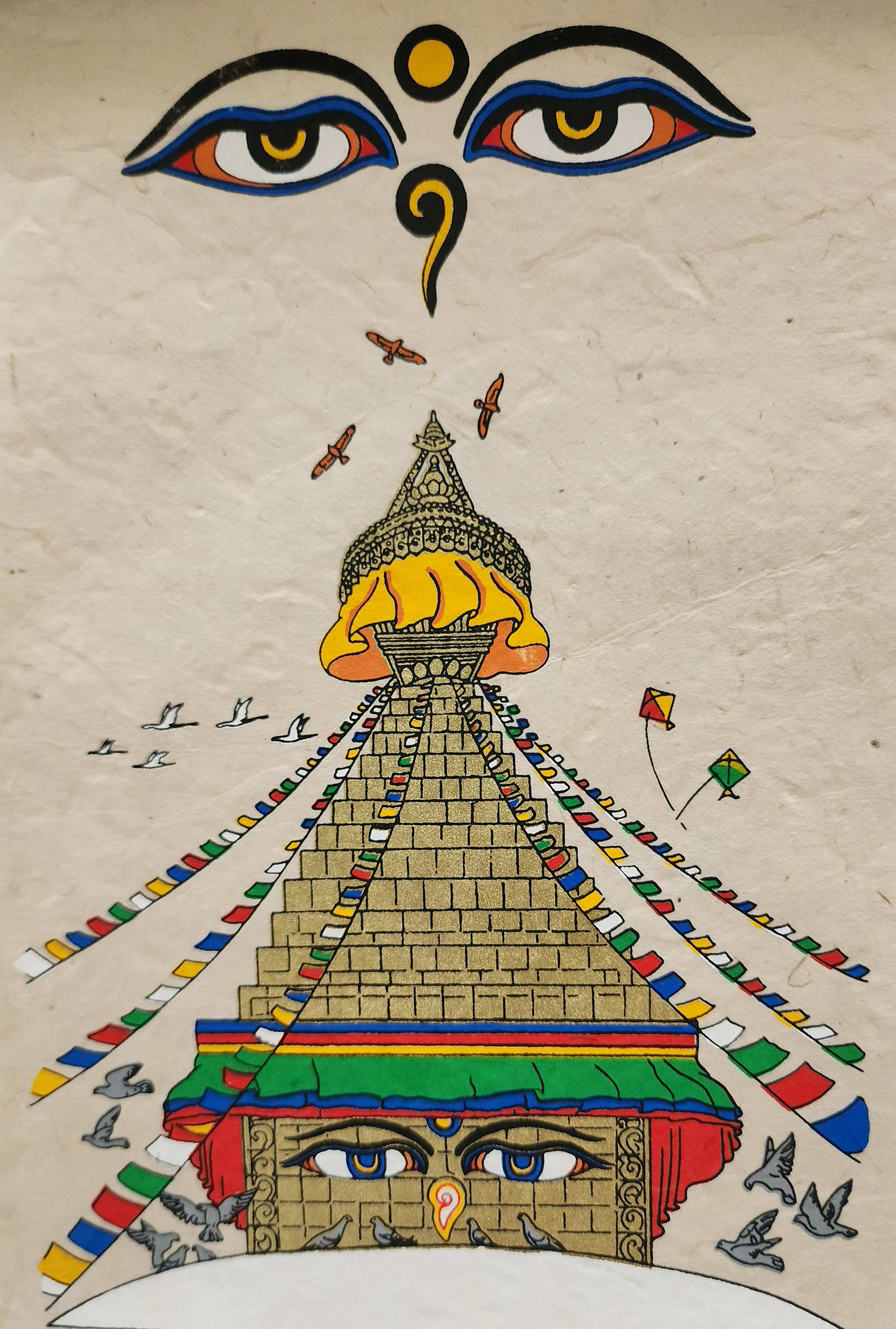 Screen Printed,
Screen Printed, 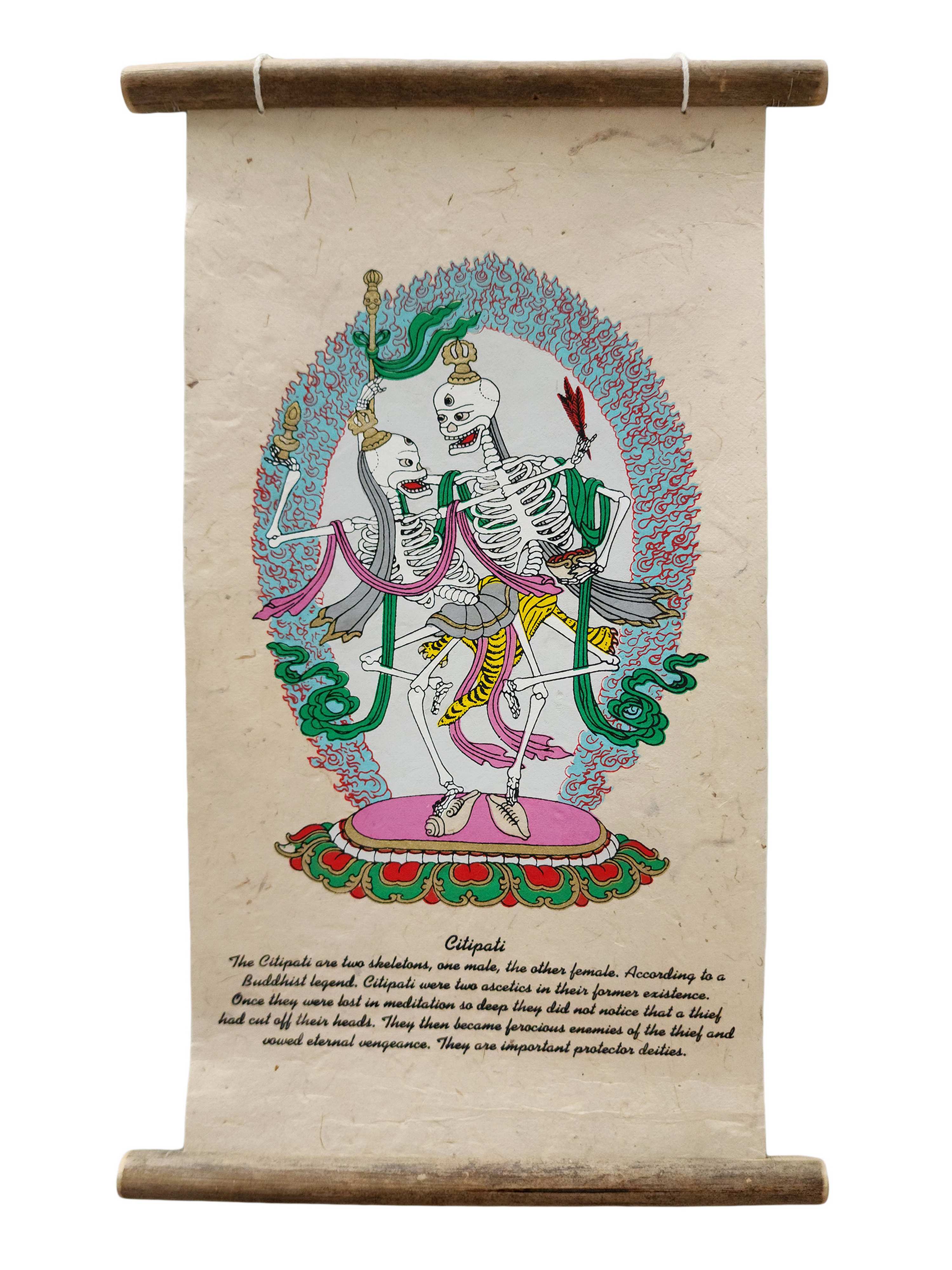 Screen Printed,
Screen Printed, 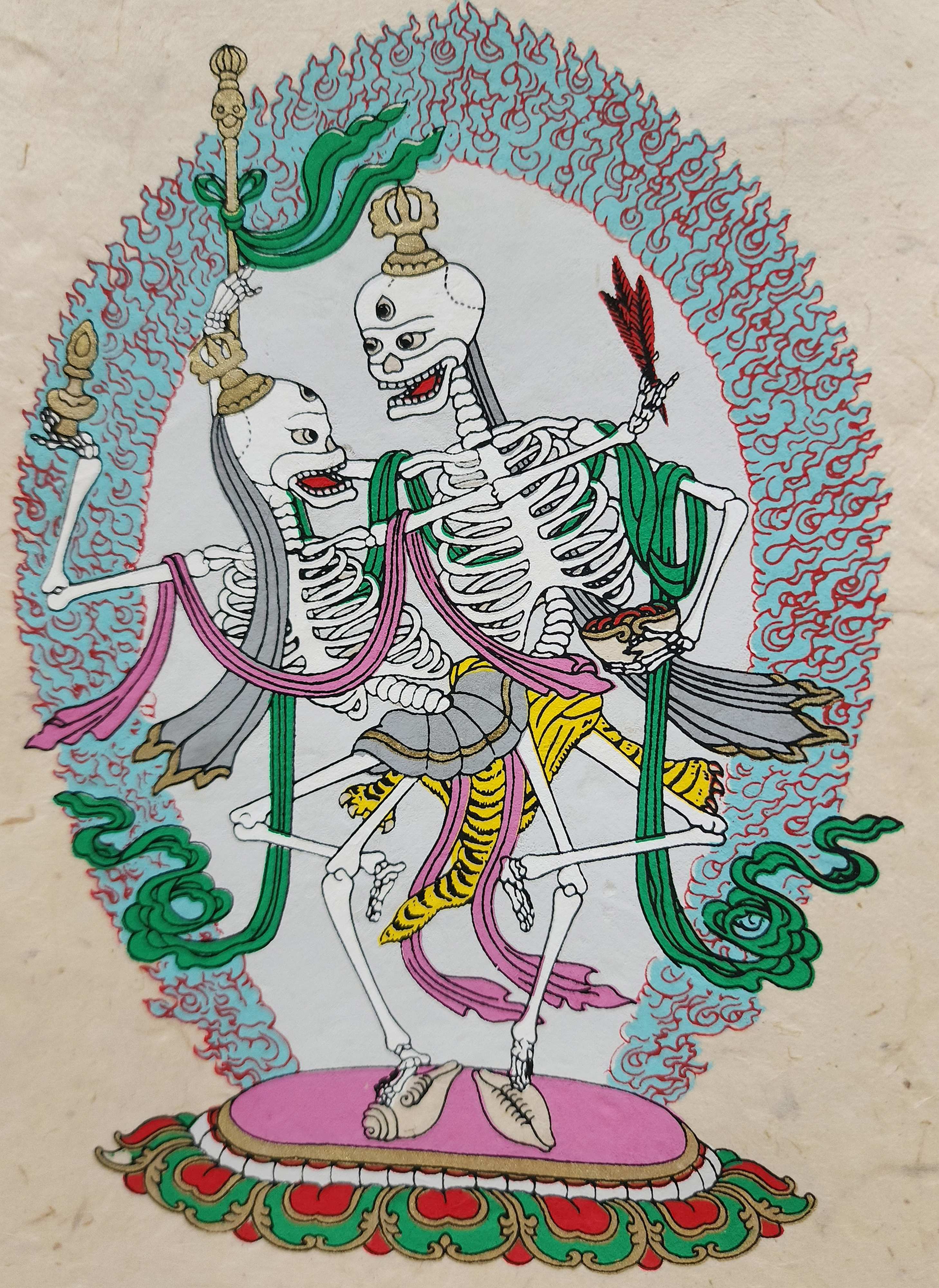 Screen Printed,
Screen Printed,